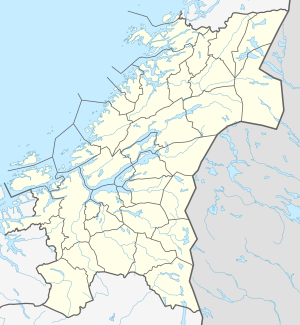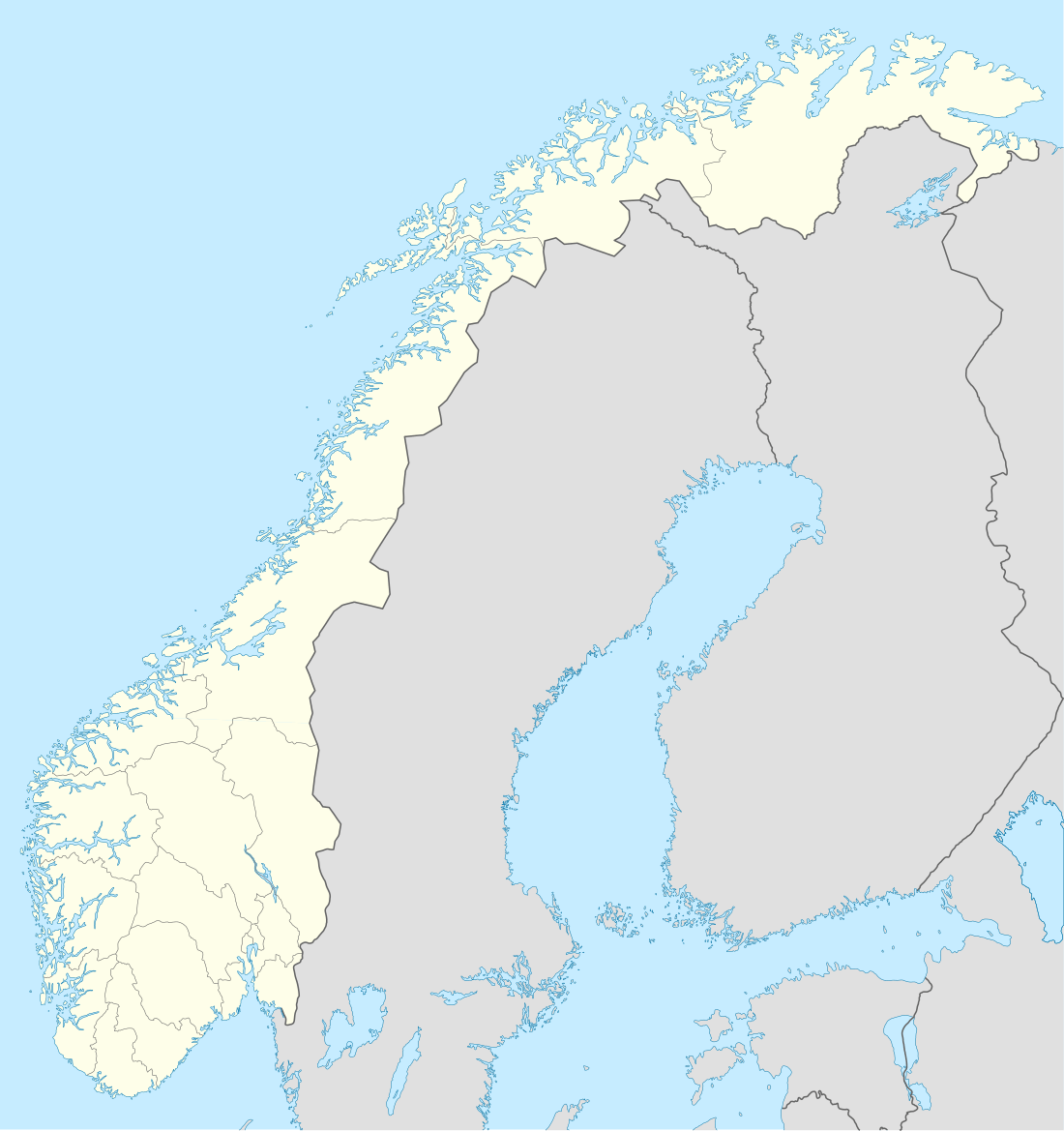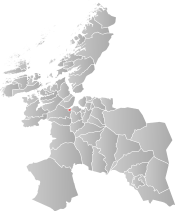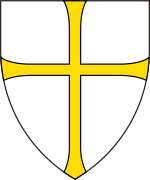Orkanger
Orkanger is a town and the administrative centre of Orkland municipality in Trøndelag county, Norway. The town is also a former municipality which existed from 1920 until 1963. The town sits at the end of the Orkdalsfjorden, and arm of the Trondheimsfjord. Orkanger is the commercial centre of the municipality of Orkland and it is the site of the Orkanger Church. It was established as a "town" in 2014.[4]
Orkanger | |
|---|---|
 View of the industrial area with the city in the background | |
 Orkanger Location of the town  Orkanger Orkanger (Norway) | |
| Coordinates: 63.3067°N 09.8502°E | |
| Country | Norway |
| Region | Central Norway |
| County | Trøndelag |
| District | Orkdalen |
| Municipality | Orkland |
| Established | 2014 (as a town) |
| Area | |
| • Total | 6.26 km2 (2.42 sq mi) |
| Elevation | 11 m (36 ft) |
| Population (2018)[1] | |
| • Total | 8,204 |
| • Density | 1,311/km2 (3,400/sq mi) |
| Demonym(s) | Ørbygg |
| Time zone | UTC+01:00 (CET) |
| • Summer (DST) | UTC+02:00 (CEST) |
| Post Code | 7300 Orkanger |
 Sør-Trøndelag within Norway | |
 Orkanger within Sør-Trøndelag | |
| Country | Norway |
| County | Sør-Trøndelag |
| District | Orkdalen |
| Established | 1 July 1920 |
| Disestablished | 1 Jan 1963 |
| Administrative centre | Orkanger |
| Area | |
| • Total | 7 km2 (3 sq mi) |
| *Area at municipal dissolution. | |
| Population (1962) | |
| • Total | 2,874 |
| • Density | 410/km2 (1,100/sq mi) |
| Demonym(s) | Ørbygg[3] |
| ISO 3166 code | NO-1639 |
| Preceded by | Orkdal in 1920 |
| Succeeded by | Orkdal in 1963 |
Combined with the neighboring suburban village of Fannrem, the conurbation constitutes one of the largest urban areas in Trøndelag county. The 6.26-square-kilometre (1,550-acre) town has a population (2018) of 8,204 and a population density of 1,311 inhabitants per square kilometre (3,400/sq mi).[1]
Just north of Orkanger lies the port of Thamshavn. Until 1974, Orkanger had a station on the Thamshavn Line railway with the Thamshavn Station just north of the city. Between 1908 and 1949 there was a steam ship service to Trondheim on the SS Orkla. The European route E39 highway runs through the town, connecting it to the major city of Trondheim, about 40 kilometres (25 mi) to the northeast.
History
The urban area of Orkanger was established as a municipality on 1 July 1920 when it was separated from Orkdal municipality. Initially, it had a population of 1,715. The municipality encompassed the 7-square-kilometre (2.7 sq mi) urban area and some of the surrounding countryside. It was an important port, but it did not have the designation of a town at that time.
During the 1960s, there were many municipal mergers across Norway due to the work of the Schei Committee. On 1 January 1963, the municipality of Orkanger ceased to exist and it was merged into the larger municipality of Orkdal. Prior to the merger, Orkanger had 2,874 residents.[5] In 2014, the municipality of Orkdal declared Orkanger to be a "town".
Municipal council
During its time as an independent municipality, the municipal council (Herredsstyre) of Orkanger was made up of representatives that were elected to four year terms. The party breakdown of the final municipal council was as follows:
| Party Name (in Norwegian) | Number of representatives | |
|---|---|---|
| Labour Party (Arbeiderpartiet) | 12 | |
| Conservative Party (Høyre) | 2 | |
| Communist Party (Kommunistiske Parti) | 5 | |
| Liberal Party (Venstre) | 2 | |
| Total number of members: | 21 | |
| Party Name (in Norwegian) | Number of representatives | |
|---|---|---|
| Labour Party (Arbeiderpartiet) | 13 | |
| Conservative Party (Høyre) | 2 | |
| Communist Party (Kommunistiske Parti) | 3 | |
| Christian Democratic Party (Kristelig Folkeparti) | 1 | |
| Liberal Party (Venstre) | 2 | |
| Total number of members: | 21 | |
| Party Name (in Norwegian) | Number of representatives | |
|---|---|---|
| Labour Party (Arbeiderpartiet) | 11 | |
| Conservative Party (Høyre) | 2 | |
| Communist Party (Kommunistiske Parti) | 3 | |
| Christian Democratic Party (Kristelig Folkeparti) | 1 | |
| Liberal Party (Venstre) | 3 | |
| Total number of members: | 20 | |
| Party Name (in Norwegian) | Number of representatives | |
|---|---|---|
| Labour Party (Arbeiderpartiet) | 10 | |
| Communist Party (Kommunistiske Parti) | 5 | |
| Liberal Party (Venstre) | 5 | |
| Total number of members: | 20 | |
| Party Name (in Norwegian) | Number of representatives | |
|---|---|---|
| Labour Party (Arbeiderpartiet) | 10 | |
| Communist Party (Kommunistiske Parti) | 6 | |
| Liberal Party (Venstre) | 4 | |
| Total number of members: | 20 | |
| Party Name (in Norwegian) | Number of representatives | |
|---|---|---|
| Labour Party (Arbeiderpartiet) | 12 | |
| Conservative Party (Høyre) | 1 | |
| Communist Party (Kommunistiske Parti) | 3 | |
| Liberal Party (Venstre) | 4 | |
| Total number of members: | 20 | |
Name
The name "Orkanger" is composed of the name "Ork", which stems from the lake Orkelsjøen from which the river Orkla runs. The second element of the name (Old Norse: angr) means "narrow fjord".[4]
References
- Statistisk sentralbyrå (1 January 2018). "Urban settlements. Population and area, by municipality".
- "Orkanger, Orkdal (Trøndelag)". yr.no. Retrieved 2018-02-03.
- "Navn på steder og personer: Innbyggjarnamn" (in Norwegian). Språkrådet.
- Store norske leksikon. "Orkanger. – kommune" (in Norwegian). Retrieved 2011-01-28.
- Jukvam, Dag (1999). "Historisk oversikt over endringer i kommune- og fylkesinndelingen" (PDF) (in Norwegian). Statistisk sentralbyrå.
- "Kommunevalgene og Ordførervalgene 1959" (PDF) (in Norwegian). Oslo: Statistisk sentralbyrå. 1960. Retrieved 2020-04-20.
- "Kommunevalgene og Ordførervalgene 1955" (PDF) (in Norwegian). Oslo: Statistisk sentralbyrå. 1957. Retrieved 2020-04-20.
- "Kommunevalgene og Ordførervalgene 1951" (PDF) (in Norwegian). Oslo: Statistisk sentralbyrå. 1952. Retrieved 2020-04-20.
- "Kommunevalgene og Ordførervalgene 1947" (PDF) (in Norwegian). Oslo: Statistisk sentralbyrå. 1948. Retrieved 2020-04-20.
- "Kommunevalgene og Ordførervalgene 1945" (PDF) (in Norwegian). Oslo: Statistisk sentralbyrå. 1947. Retrieved 2020-04-20.
- "Kommunevalgene og Ordførervalgene 1937" (PDF) (in Norwegian). Oslo: Statistisk sentralbyrå. 1938. Retrieved 2020-04-20.

